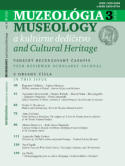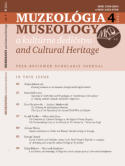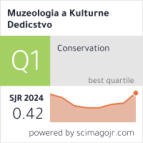

MUZEOLÓGIA
MUSEOLOGY
a kultúrne dedičstvo
and Cultural Heritage

News
Journal Muzeológia a
kultúrne dedičstvo -
Museology and Cultural
Heritage:
SJR 2024: 0,424 (Q1)
Museology SJR rank: 8/83 (Q1) Conservation SJR rank: 11/103 (Q1)JIF WoS 2023: 0,6
JCI WoS 2023: 1,28, Q1 ESCI: 49/411 (Q1)New issue
Muzeológia a kultúrne
dedičstvo 2/2025
online New volume Studia Museologica Slovaca, vol. 8 (2024) online New volume Populačné štúdie Slovenska 17 (2024) onlineNew book
P. Tišliar (ed.). Osobnosti uměleckoprůmyslového muzejnictví (2025) online
Contents 4/2021
Title: Fostering inclusion in art museums through mobile digital content
Abstract: This paper deals with digitally mediated museum experiences of novice visitors at the Kunsthistorisches Museum in Vienna
and discusses them in the context of museum inclusion. Research participants included families with young children and members of
minority communities in Vienna whose visit was facilitated by two app-based guided tours developed for children. The research goal
was to explore the impact of the mobile guide’s digital content and modes of communication on the visitors’ interaction with the guide,
with the museum space and objects, and with family members. The families’ interactions were observed, recorded and analyzed. The
results suggest that carefully considered and created content on mobile guides has the potential to provide novice family visitors with
experiences that support their independence and active engagement, create opportunities for mutual facilitation, and support their
different identities, all of which have been considered as conducive to inclusion.
Author: Željka Miklošević
Publication order reference: Faculty of Humanities and Social Science, University of Zagreb, (Department of Information and
Communication Sciences, Museology Unit), Ivana Lučića 3, 10000 Zagreb, Croatia, e-mail: zmiklose@ffzg.hr, ORCID: 0000-0003-
2742-3508
Source: Muzeológia a kultúrne dedičstvo, year: 2021, vol.: 9, number: 4, pages: 5-19.
Key words: art museum, mobile guide, novice visitors, multimodality, inclusion
Language: English
online full-text PDF
DOI: 10.46284/mkd.2021.9.4.1
Title: Museums of martyrdom and the pedagogy of remembrance in the context of shaping students’
attitudes and future competences
Abstract: Museums of martyrdom operate on the sites of former Nazi concentration camps in Poland as memorials to the events of
the Second World War. These institutions are part of the pedagogy of remembrance, which is an educational discipline connected with
the theories of the German philosopher Theodor W. Adorno. The pedagogy of remembrance assumes that as part of the didactic
process, it is important not only to learn about atrocities, but above all to analyse their causes. The discussion and debate surrounding
the pedagogy of remembrance have allowed this article to identity the correlation between its assumptions and the shaping of
students’ attitudes as well as the development of skills included in the key competences. These competences are also referred to in a
broader sense as competences of the future, as they are necessary for an individual to function properly in society. The aim of this
article is therefore to clarify whether and how museums of martyrdom and the pedagogy of remembrance can foster the development
of the skills defined as competences of the future. This article also attempts to indicate the museum activities and didactic methods
that can be used by educators at places of remembrance in order to shape attitudes and develop key competencies.
Authors: Marta Milewska
Publication order reference: OBBH IPN in Warsaw, Poland, e-mail: m.milewska@vistula.edu.pl, ORCID:0000-0003-3283-4037
Source: Muzeológia a kultúrne dedičstvo, year: 2021, vol.: 9, number: 4, pages: 21-39.
Keywords: museum, museum of martyrdom, pedagogy of remembrance, key competences, competences of the future
Language: English
online full-text PDF
DOI: 10.46284/mkd.2021.9.4.2
Title: On Defining the Participatory Museum: The Case of the Museum of the Second World War in
Gdansk
Abstract: This article seeks to contribute to the current debate on the new definition of the “museum” – a debate which led to turmoil
at the 2019 ICOM General Assembly in Kyoto. With reference to the case study of the Museum of the Second World War in Gdansk
(MSWW), it analyses the new and very successful genre of the narrative museum, a genre which arguably fulfils the core elements of
the definition currently being discussed by ICOM. In this regard, it brings into focus the paramount importance of community
involvement in creating and managing narrative museums – an aspect that has been virtually absent in the academic and media
debates over the nature of the MSWW and its programme. By pointing out the fragility of the foundations for such participation, based
solely on trust between communities, the museum, and state authorities, this article calls for and provides guidance for an academic
and institutional redefinition of the narrative museum and the institution of a museum in general.
Author: Ewa Manikowska – Andrzej Jakubowski
Publication order reference: Institute of Art, Polish Academy of Sciences, Warsaw, Poland, e-mail: ewa.manikowska@ispan.pl,
ORCID: 0000-0001-6633-823X, Institute of Legal Studies, University of Opole, Opole, Poland, e-mail:
andrzej.jakubowski@uni.opole.pl, ORCID: 0000-0002-4914-7068
Source: Muzeológia a kultúrne dedičstvo, year: 2021, vol.: 9, number: 4, pages: 41-55.
Keywords: narrative museum, participation, community, human rights, Museum of the Second World War in Gdansk
Language: English
online full-text PDF
DOI: 10.46284/mkd.2021.9.4.3
Title: The Protection of Cultural Heritage vs. the Right to Private Property: The Extraordinary Case of
the Portrait of Dr. Gachet by Vincent van Gogh
Abstract: In 1890, Vincent van Gogh moved from Paris to Auvers-sur-Oise, where he met Dr. Paul-Ferdinand Gachet, who agreed to
host and take care of the painter, especially regarding his mental health. However, he did not manage to save the artist, who
committed suicide the same year. His hopeless mental health was seen in the famous portrait of Dr. Gachet, which radiated a distinct
melancholy and sadness. The Portrait of Dr. Gachet was bought for $ 82.5 million by a Japanese millionaire and art collector, Ryoei
Saito, who said that after his death it was to be burned along with his corpse. It raised loud objections in the art world, which
recognised the common good and the legacy of our cultural heritage in the painting. This case is a classic example of a dispute
between the ideals of liberalism and communitarianism and is seen as a hard case in law. The aim of the article is to present the
history of The Portrait of Dr. Gachet and its place in the dispute between liberalism and communitarianism (in the context of cultural
heritage law), which in turn means that this case can be seen as a hard case.
Authors: Kamil Zeidler – Aleksandra Guss
Publication order reference: University of Gdańsk, Faculty of Law and Administration, Department of Theory and Philosophy of the
State and Law, Corresponding adress: ul. Jana Bażyńskiego 6, 80-952 Gdańsk, e-mail address: kamil.zeidler@ug.edu.pl, ORCID:
0000-0002-8396-3608, e-mail address: aleksandra.guss@phdstud.ug.edu.pl, ORCID: 0000-0002-4157-6853
Source: Muzeológia a kultúrne dedičstvo, year: 2021, vol.: 9, number: 4, pages: 57-68.
Keywords: Cultural Heritage Law, Art Law, Hard Cases, Liberalism vs. Communitarianism, Philosophy of Law
Language: English
online full-text PDF
DOI: 10.46284/mkd.2021.9.4.4
Title: Islamic architecture in Tbilisi and Batumi: Muslim heritage in Georgia
Abstract: Georgia’s cultural wealth is the result of the country’s centuries-old history and complex ethnic, religious and political
relations. Islam, present in these areas since the seventh century, was of significant importance for the shaping of Georgian
architecture. Architectural elements characteristic of Middle Eastern art were thus transferred to a Christian country. Arabs and
Persians left behind buildings and ornamental details. The article is the result of field research carried out in Georgia, the purpose of
which was to identify the issues of shaping and preserving memory and cultural and religious identity in the Muslim community.
Georgian Muslim architecture is heavily neglected and requires increased protection, and above all significant financial resources that
are difficult to obtain from a small number of Islamic communities. On the other hand, contemporary trends in Georgian architecture
are realized and financed by Muslim businesses.
Authors: Aldona Piwko
Publication order reference: Vistula University in Warsaw, e-mail: a.piwko@vistula.edu.pl, ORCID: 0000-0003-2300-4306
Source: Muzeológia a kultúrne dedičstvo, year: 2021, vol.: 9, number: 4, pages: 69-83.
Keywords: Christianity, Islam, cultural heritage, architecture, Georgia
Language: English
online full-text PDF
DOI: 10.46284/mkd.2021.9.4.5
Title: Greek Catholic and Orthodox shrines in the Polish People’s Republic as examples of destroying
and saving the cultural heritage of the frontier
Abstract: The shrine constituting the centre of spirituality was inseparable from the religious life of the Ukrainian people. The
deportations of Ukrainians from the south-east of Poland in 1944–1947 exposed their churches to intentional and unintentional
devastation. The communist authorities aimed to erase the traces of Ukrainian people in that area therefore they were not interested in
preserving the abandoned Greek Catholic shrines. What is more, they even encouraged their demolition. One way to save them was
allowing them to be taken over by the Roman Catholic Church. However, it often involved a change to their interior décor. The best
solution was allowing them to be taken over by the Orthodox Catholic Church, or transferring them to open-air museums as museum
objects.
Authors: Roman Drozd
Publication order reference: Pomeranian University in Słupsk, Institute of History, Arciszewskiego 22 a, 76-200 Słupsk, Poland
e-mail: roman.drozd@apsl.edu.pl, ORCID: 0000-0003-0169-7295
Source: Muzeológia a kultúrne dedičstvo, year: 2021, vol.: 9, number: 4, pages: 85-97.
Keywords: Greek Catholic Church, Orthodox Catholic Church, shrines, Ukrainian people, Poland 1944–1989
Language: English
online full-text PDF
DOI: 10.46284/mkd.2021.9.4.6
In Practice
Title: Local history and museology in Dagestan: trends and prospects of interrelated development
Abstract: The article describes the historical periods of development two closely related fields of activity in Daghestan (Russia) – local
history and museology. Within each period, the authors highlight the stages of the local history and museum initiative of the local
intellectuals and educators. The spatio-temporal dynamics of the network of local history museums in the context of the republic’s
municipalities is analysed. The features of the evolution of local lore and museum affairs are revealed in the light of the prospects for
the popularisation of the rich natural and cultural heritage of the “Country of the Mountains”. The issues surrounding the formation of
effective museum and tourist clusters on this territory are discussed.
Authors: Eldar Eldarov – Murtazali Gadzhiev
Publication order reference: Faculty of Management, Daghestan State University. Chairman of the Daghestan branch of the Russian
Geographical Society, Makhachkala, Russian Federation, e-mail: geodag@mail.ru, ORCID: 0000-0002-9873-4437, Institute of History,
Archeology and Ethnography, Daghestan Federal Research Centre of RAS, Makhachkala, Russian Federation, e-mail:
murgadj@rambler.ru, ORCID: 0000-0002-4592-0527
Source: Muzeológia a kultúrne dedičstvo, year: 2021, vol.: 9, number: 4, pages: 99-113.
Keywords: local lore studies, local history museums, cultural tourism, museum and tourist cluster, Daghestan
Language: English
online full-text PDF
DOI: 10.46284/mkd.2021.9.4.7
Articles (Abstracts)

Full-text version
DOI:10.46284/mkd.2021.9.4.0
ISSN 1339-2204
eISSN 2453-9759
Vol. 9 (2021), No. Is. 4



























